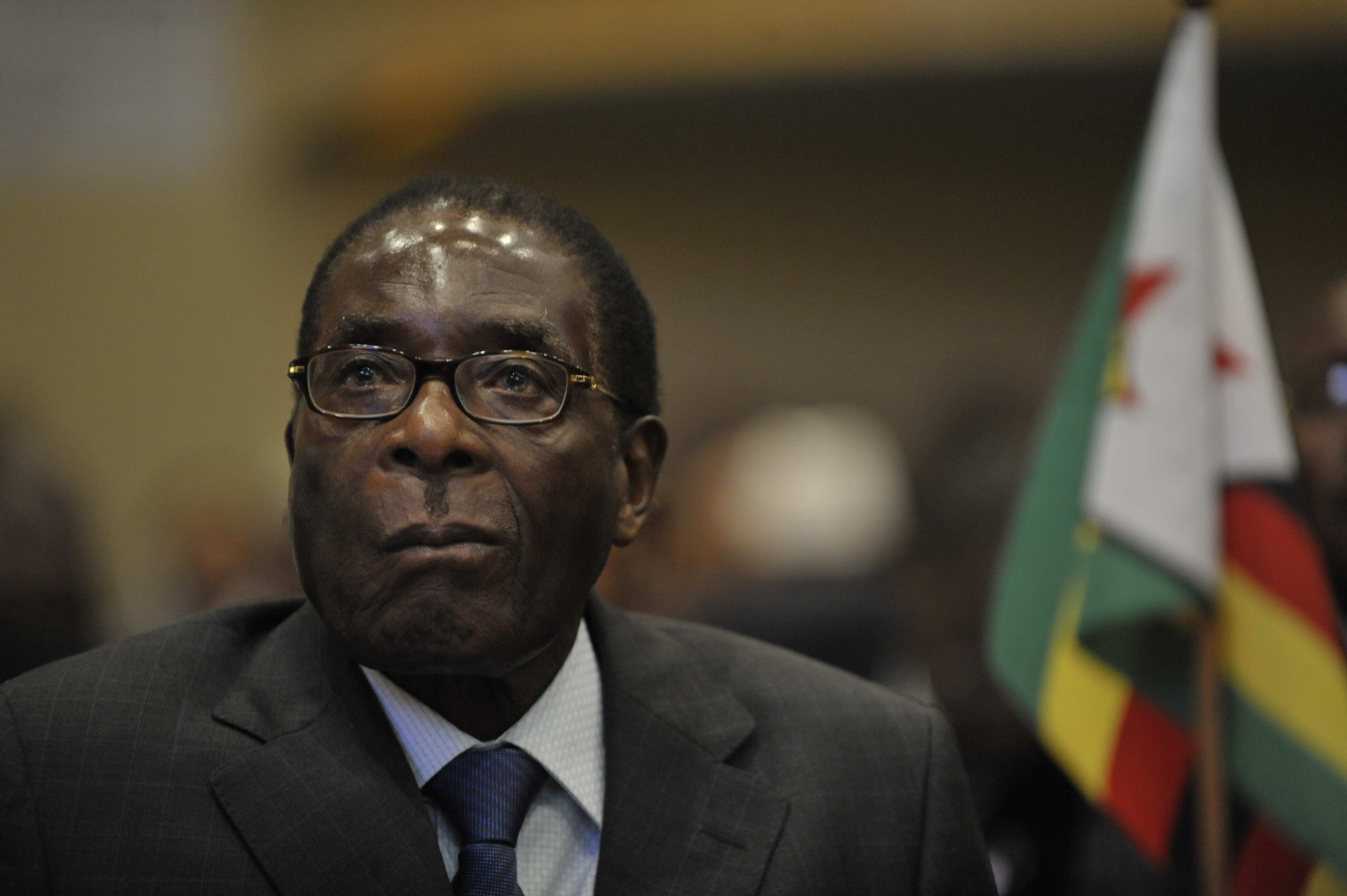By Philippe Hugon
Translation: Lawrence Myers
Passage au crible n° 124
 Source: Wikimedia
Source: Wikimedia
The 24th Summit of the AU (African Union) was held in Addis Ababa from January 21-28, 2015. The major issues were related to the “Year of Women’s Empowerment and Development towards Africa’s Agenda 2063”. The question of the Ebola epidemic was addressed with a request for cancellation of debt up to 3 billion US dollars for the three countries concerned: Guinea, Liberia and Sierra Leone. The Peace and Security Council was held on January 29 with 15 heads of state in attendance, but without the Nigerian President, Good Luck Jonathan. On the authority’s agenda was the fight against terrorism, particularly targeting Boko Haram. Appealing to UN financing, a multinational force of 7,500 was proposed.
However, the highlight was the designation of the president of Zimbabwe, Robert Mugabe, as the new president of the African Union. At 90 years old, this autocrat in power for 35 years, hero of the fight against Apartheid, increased criticism of the West. His election symbolizes the contradiction of African countries expressing an anti-western Pan-Africanism, despite member states’ inability to deal autonomously with questions related to peace and security or to solve the problem of epidemics. It also testifies to the constancy of gerontocrats, presidents for life, in the face of the African youth seeking their place in the political game and which, in so doing, opposes constitutional manipulations.
> Historical background
> Theoretical framework
> Analysis
> References
Historical background
The African Union reinforced the political integration of Africa by implementing the NEPAD (The New Partnership for the Development of Africa) and the transformation in 2002 of the OAU (Organization of African Unity) into the AU (African Union). Today the AU is an assembly of 53 African states. Yet, Morocco is not a member due to the position adopted by the OAU, and then the AU, in favor of the independence of Western Sahara. The AU reinforced its institutional strength (Assembly, Executive Council, Permanent Representatives’ Committee and Commission). Initially a coordination organization, it has now turned into an institution of integration modeled after the European Union.
The Action Plan, adopted in Ouagadougou on October 12, 2014, had defined five priorities:
1/ institutional transformation (Pan-African Parliament); 2/ promotion of peace (Peace and Security Council), human security and governance (African Court of Human Rights the Peoples); 3/ regional development and integration; 4/ construction of a shared vision within the continent; 5/ adoption of protocol relative to the Court of Justice of the UA. It otherwise provided for the designation of a president of the UA for one year, while the president of the commission would be elected for a 5-year term.
The UA made two major innovations in relation to the OAU: 1/ It allowed for sanctions to be imposed on member states not respecting policies and decisions by the AU. Besides that, the 2007 charter strengthened the objectives in terms of democracy and governance. 2/ It recognized a right of intervention when legitimate order is threatened; a decision that goes against the principle of non-intervention, protector of sovereignties. Created in 2003 for deployment in the context of peacekeeping or peace support missions, the African reserve force is divided into five regional brigades integrated into the African architecture of peace and security of the African Union.
The reality remains far from these norms since the margins of maneuver of the AU appear slim in the face of the EU and its financing. Yet, it should be noted that with the disappearance of certain African leaders (Gaddafi, Wade) who would have wanted to promote a government of the United States of Africa, the AU has experienced a loss of influence. Especially since this ambition has clashed with the reticence of South Africa, and with the division between Arab-Muslim Africa and Sub Saharan Africa and the weak regional integration.
Ultimately, the election of Robert Mugabe as president of the organization strengthens the weight of South Africa. Like the election of Ms. Dlamini-Zuma in July 2012, as president of the Commission, the election of Mr. Mugabe is a result of alliances formed during the fight against Apartheid. It also confirms the relative unity of the bloc of the SADC (Southern Africa Development Community) in the face of the ECCAS (Economic Community of Central African States) and the ECOWAS (Economic Community of West African States) and French-speaking countries represented by the OIF (Organisation Internationale de la Francophonie) and especially Nigeria.
Theoretical framework
The weakness of the African Union refers to two main elements.
1. A conflict of interests. The African Union reflects the rivalries between member states. It is marked by the opposition between two rival powers: Nigeria and South Africa. They want to exert a continental leadership and aim long-term to obtain a seat as a permanent member of the United Nations Security Council.
2. A poor collective mobilization in favor of security. The pan-African rhetoric of the pax Africana stumbles in the face of weak financing and low-level engagement in favor of peace and security. To the point that the architecture of peace and security functions poorly on the continent. Faced with conflicts, the development of terrorism and jihadism in Libya, Sudan, Somalia, Mali, Nigeria in the region of Lake Chad, in the Central African Republic or else in the DRC, the African Union has not known how or else has been unable to demonstrate its authority. Thus, the African force available to fight Boko Haram finds itself confronted with financing difficulties and the difficult implementation of a multilateral framework. So that the African forces involved in the background, behind armed nationals or bilateral forces before being relieved by United Nations forces.
Analysis
Despite the African Commission of Human Rights and Peoples, the AU continues to remain far behind concerning the infringement of rights taking place in numerous countries, notably in DRC Congo, Côte d’Ivoire, Somalia and Zimbabwe. The same goes as to denials of democracy or when it comes to addressing popular uprisings (i.e., the “Arab Springs” taking place since January 2011). Most often, constitutional manipulations aim to free themselves from rules guaranteed by Constitutional Courts or Councils. Thus, a connection exists in Africa between the duration of mandates and the personalization of power and the risk of authoritarian tendencies. This explains that elections of a contentious nature have led to crises in Côte d’Ivoire (2000, 2010), Kenya (2007, 2008), Zimbabwe (2007) or in RDC (2011); identity clientelism having only been exceeded in certain rare cases (Ghana, Senegal, Kenya, in 2013).
The election of a gerontocrat or autocrat Robert Mugabe also presents a challenge to African youth. Certainly, his populism and the fight against British mining interests are still of a certain echo. But his role in the fight against Apartheid is henceforth a thing of the past. Young Zimbabweans today are subjected to the effects of the country’s agrarian reform which – in giving land to war veterans – has ruined their agriculture. This is why they are submitted to a regime controlled by the army. Still, African youth – time bomb or change factor – now intend to participate in the political, social and economic life of the continent. However, demographic majority, the youth remain the social and political minority. A consequence of their lack of perspective, they often waver between resignation and contestation; showing that they are listening to all types of extremists (oppositions to imams and Sunnite brotherhoods, Shiism in Senegal or in Nigeria, evangelical churches).
Mugabe’s victory also underscores the failure of the UA in the domain of peace and security. Of course, this organization recommended an African intervention force against Boko Haram, which continues to commit crimes against humanity. To do this, it sweeps aside the reluctance of Nigeria worried about its national sovereignty. On the other hand, its declaration of intent simply accompanies regional initiatives of countries neighboring Lake Chad, members of The Lake Chad Basin Commission and the logistical support of France or the United States. Finally, it has a serious lack of financing and of consensus, with only 40% of its budget coming from member contributions.
Beyond rhetoric, the AU must develop the principles it has proclaimed in matters of democracy, governance and intervention. But this implies financing by member states, notably those that – mining or oil countries – have significant financial resources. Transfers of sovereignty and production of public goods on a regional scale could be the answer to the overflow of sovereignties in a transnational context. In the same way, regional economic integration could help to counter the economic dependence of state actors. However, a process such as this assumes strong, democratic states that are capable of avoiding territorial fragmentation; a public power that would be based on a civil society equipped with counterpowers and recognizing the rights of minorities. Still, the election of Mugabe radically contradicts this orientation.
References
Nougarel Fou, Briga LMI, L’architecture de paix et de sécurité en Afrique : bilan et perspectives, Actes colloques, Bordeaux, Ouagadougou, Nov. 2012-Oct. 2013.
Philippe Hugon, Géopolitique de l’Afrique, 3e ed., Paris, SEDES 2013.
Romuald Likibi, La charte africaine pour la démocratie, les élections et la gouvernance, Paris, Publibook 2012.




